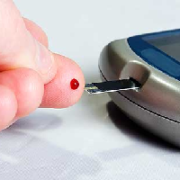Type II Diabetes Reaching Epidemic Status
Type II diabetes continues to climb in the United States.
The number of Americans with diabetes continues to increase, according to CDC’s most recent National Diabetes Fact Sheet. So does the number of Americans with pre-diabetes, a condition that increases their risk of type 2 diabetes, heart disease and stroke. The National Diabetes Fact Sheet, provides data on how many Americans have diabetes, as well as information on age, racial and ethnic differences in diabetes, and on complications of the disease. Below are some highlights from the fact sheet.
Diabetes affects 8.3% of all Americans and 11.3% of adults age 20 and older.
Some 27% of people with diabetes – 7 million Americans – do not know they have the disease. In 2010, 1.9 million Americans were first diagnosed with diabetes.
Pre-diabetes affects 35% of adults age 20 and older, and half of Americans age 65 and older.
Pre-diabetes is a condition in which blood glucose (sugar) levels are higher than normal, but not high enough to be diagnosed as diabetes.
The CDC estimates that as many as 1 in 3 U.S. adults could have diabetes by 2050 if current trends continue. Type 2 diabetes, in which the body gradually loses its ability to use and produce insulin, accounts for 90% to 95% of cases.
Risk factors for type 2 diabetes include older age, obesity, family history, having diabetes while pregnant, a sedentary lifestyle and race/ethnicity.
In The New England Journal of Medicine, Robert Steinbrook, M.D. stated:
“The diabetes epidemic in the United States continues unabated, with a staggering toll in acute and chronic complications, disability, and death.”
He continues…
“The primary culprits are poor glycemic control over the long term and other major risk factors, such as hypertension, cigarette smoking, obesity, and elevated levels of cholesterol or blood lipids.”
Children With Type 2 Diabetes Now Common
To make matters worse, type 2 diabetes is no longer a disease of older adults, but children and young adults as well.
In an article published in July, 2008 in an issue of the Archives of Pediatric & Adolescent Medicine, pediatric endocrinologist Joyce Lee, M.D. stated:
“Recent studies suggest that there have been dramatic increases in type 2 diabetes among individuals in their 20s and 30s, whereas it used to be that individuals developed type 2 diabetes in their late 50s or 60s…”
Children Under 20 years of age:
215,000, or 0.26% of all people in this age group have diabetes
About 1 in every 400 children and adolescents has diabetes
What is so different in today’s society that seems to be causing this disease to be on an increase?
People with type 2 diabetes suffer from multiple nutritional deficiencies.
Biotin
Research has shown, those with type 2 diabetes often have low levels of the vitamin, biotin. This is a significant finding because biotin appears to be involved in the synthesis and release of insulin.
In other words, when there is a biotin deficiency, glucose (blood sugar) utilization is impaired. It appears that biotin helps improve blood sugar control.
 |
| Diabetic Support Formula |
An article based on a study related to the pharmacological effects of biotin from The Journal of Nutritional Biochemistry found that patients with type 2 diabetes had high blood glucose levels that corresponded to lower biotin levels, whereas, the non-diabetic control subjects had lower fasting blood glucose levels that corresponded to higher blood biotin levels.
In order to see if an association existed, the patients with type 2 diabetes where given a supplementation of 9,000 mcg/day of biotin for one month.
The results were significant.
After one month, their fasting blood glucose levels decreased by an average of 45%!
A study done in 2006, found that biotin also seems to have an effect on lowering triglyceride levels; in both the diabetes group as well as the control group.
“We conclude that pharmacological doses of biotin decrease hypertriglyceridemia. The triglyceride-lowering effect of biotin suggests that biotin could be used in the treatment of hypertriglyceridemia.”
Yet another study, involved patients who took biotin in combination with chromium(a vital trace mineral used in the body for carbohydrate metabolism and insulin regulation.)
The result showed improvement in blood sugar levels, decrease in LDL cholesterol and triglyceride levels, and an increase in HDL cholesterol levels.
Studies like these prove the gross nutritional deficiencies that are so apparent in today’s society. Poor diet, living on an over abundance of carbohydrate processed foods, cereals, bagels, chips, sweets, sodas, is the bedrock of faulty metabolism and leads to type 2 diabetes.
I’ve found that the best way to eliminate type 2 diabetes is to lose weight and take the right nutritional supplements. My patients with type 2 diabetes are placed on my Jump Start Weight Loss Program and are usually able to eliminate all their diabetes meds within 2-4 weeks of starting my program. It is not unusual for my patients to lose 15-30 pounds in the first month of care. And with this program not only are patients able to discontinue most if not all of their meds for diabetes, cholesterol, and high blood pressure, they also keep the weight off that they’ve lost. I’ve got patients who’ve lost 40, 50, even 100 pounds and have kept the weight off one year later!
This program has been a godsend for my diabetic and high blood pressure patients.
You can read more about the Jump Start Weight Loss Program Here, or by calling the clinic 205-879-2383.
Here’s an entertaining and very informative past article about diabetes and the potential dangers of the common drugs used to treat it-







Type 1 diabetes since 1971. After I dropped to under 40 grams of carbohydrates a day, I had my first hemoglobin A1c under 8.5 (US measure — I’m not sure if it’s the same scale in Europe and elsewhere) in some years — still too high, but an improvement.
The range for A1C is 4.5-6.2-anything above 6.2 is high blood sugar